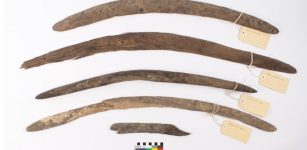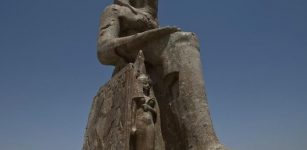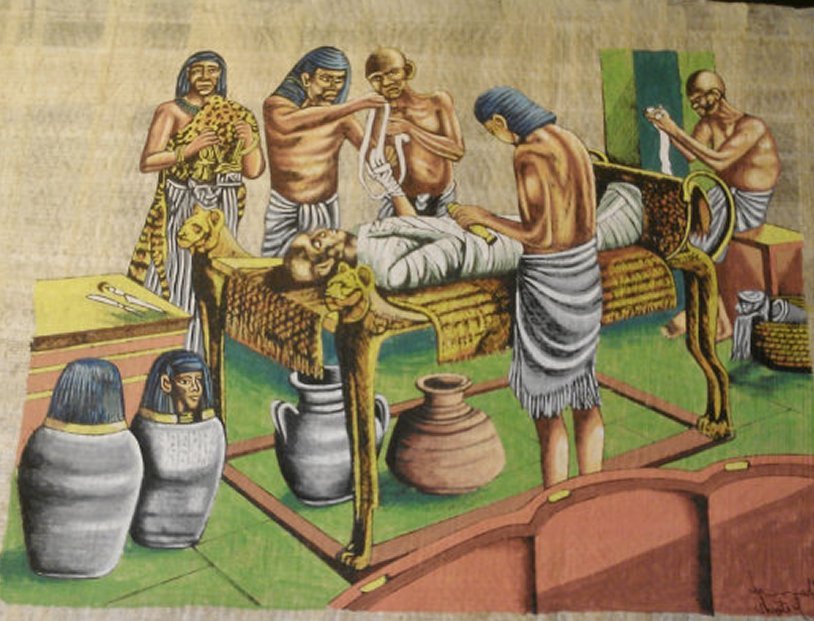Unique Chinchorro Burial Tradition For All And Ancient Egyptians Who Mummified Kings And Nobles Only
A. Sutherland - AncientPages.com - Mummies have long fascinated the world. Mummification is the great ancient tradition and has been a worldwide practice for over 7,000 years.
How were the first techniques of mummification discovered?
The internal organs were removed through the incision and then cleaned, dried, wrapped and placed in four canopic jars. Image via History In An Hour
Millennia ago, in the Middle East, the head were separated from the rest of the dead body and facial features of the dead were modeled on the skull.
It was not mummification as we know it today from archaeological evidence but it was a desire to preserve the human remains and facial features.
Over the centuries, numerous beliefs and funeral practices in many cultures were combined to preserve the posthumous existence of the dead.
In his book "The Golden Branch," James George Fraser wrote that in many cultures, there was no doubt that the aging of the body and its postmortem decay can harmfully affect the soul that inhabits it. It was therefore necessary to prevent changes that could lead to the death of the soul.
The Chinchorro culture that lived on the coast of present day northern Chile and southern Peru, created the earliest known mummies.
A Chinchorro mummy - at San Miguel de Azapa Museum in Arica, Chile; Arica is often referred to as the driest place on Earth, but locals say that is changing. Photograph: Vivien Standen/Washington Post
They preserved all their dead using elaborate techniques. The dead remained with the living and symbolized as the link between the dead and the living.
Recent research indicates that the tradition of embalming in Egypt is much older than previously thought and can match the age of Chinchorro culture.
The Egyptians constantly refined their mummification process, and by the New Kingdom period, they had perfected their techniques, so even today Roman Catholic Church follows them when preserving the bodies of deceased popes.
See also:
Mystery Of The Chinchorro Civilization And The World’s Oldest Mummies
Canopic Jars: Funerary Tradition Of Ancient Egyptians And Their Beliefs In Afterlife
Viking Burial Rituals: High Ancient Funeral Pyre Reflected High Social Status
To the ancient Egyptians, death was the next step in a great process of continuation of life – afterlife. But to participate in it, the body had to be properly preserved.
The Egyptians were wrapping their dead in linen as early as c.3400 BC, with linen impregnated with resin or sometimes with plaster to preserve the contours of the body. Around 2600 BC, they began to remove the internal organs (except for the kidneys) to prevent decomposition. The brain, which was never preserved, was removed through the nose with an instrument that looked like a hooked metal rod.
For the next three millennia, the Egyptians refined and perfected their techniques and by New Kingdom times, about 1570-1070 BC, they became the world’s most skilled and famous practitioners of mummification.
It was long believed that the Chinchorro people of Chile preserved bodies before the Egyptians. First, now researchers have been able to analyze ancient Egyptian graves at Mostagedda, Badari and Hierakonpolis and the results indicate that buried bodies were subjected to embalming treatments before being deposited in the grave.
Dating of these burials to the fifth millennium BC makes them the contemporaries of the Chinchorro mummy of South America.
However, the Chinchorro burial practices were unique in many ways.
Bernardo Arriaza, an expert on the mummies, which were first discovered in the Atacama desert in 1917, wrote that “…whereas the Egyptians considered only kings and other exalted citizens worthy of mummification, the Chinchorro accorded everyone in the community, regardless of age or status, this sacred rite…”.
Without pottery farming and literacy, the Chinchorro people were considered as primitive, but interestingly, they possessed complex mummification techniques that confirm they were a highly sophisticated culture.
From c.6000 BC, the Chinchorro began to 'rebuild' their dead, with bodies carefully removed flesh and the skin, brain and internal organs removed. The bones were dried with hot ashes before the whole lot was then reassembled using twigs for reinforcement bound tightly with reeds.
Finally, a layer of ash paste was applied over the body, a clay mask used to cover the face and a wig made of human hair was placed on the head.
At first, only infants and children, decorated with vibrant colors and diverse clay figurines. At its peak around 3000 BC, Chinchorro mummified men, women, and children of all ages and in the final days of this culture, the mummies bore only mud masks. The mummies were apparently not buried but were stood upright in a visible location in the camp, perhaps to indicate the group’s lineage from a common ancestor.
In addition, not all members of Chinchorro bands were mummified; some were buried in simple graves. Such graves have been found on elevated terraces and containing one or more individuals who may have been family groups.
Written by – A. Sutherland AncientPages.com Staff Writer
Copyright © AncientPages.com All rights reserved. This material may not be published, broadcast, rewritten or redistributed in whole or part without the express written permission of AncientPages.com
Expand for referencesReferences:
Andrews C. Egyptian Mummies: Revised Edition
Stein R. L. Stein P. Anthropology of Religion, Magic, and Witchcraft
Sciencing - In Ancient Egypt, What Did They Put in a Mummy's Stomach?
More From Ancient Pages
-
 Famous Runestone Is Not What We Thought And Re-Writes History Of The Vikings – Scholar Argues
Vikings | Jan 23, 2025
Famous Runestone Is Not What We Thought And Re-Writes History Of The Vikings – Scholar Argues
Vikings | Jan 23, 2025 -
 Nidhogg – Dreadful Winged Corpse-Eating Dragon Who Is Enemy Of Asgard And Yggdrasil Tree
Featured Stories | May 9, 2020
Nidhogg – Dreadful Winged Corpse-Eating Dragon Who Is Enemy Of Asgard And Yggdrasil Tree
Featured Stories | May 9, 2020 -
 Mystery Of The Wizard Clip – Unexplained Half-Moon Clippings And Supernatural Phenomena West Virginia
Featured Stories | Jul 15, 2024
Mystery Of The Wizard Clip – Unexplained Half-Moon Clippings And Supernatural Phenomena West Virginia
Featured Stories | Jul 15, 2024 -
 Unexpected Discovery Of 600 B.C Assyrian Palace In Shrine Destroyed By Isil Militants
Archaeology | Mar 2, 2017
Unexpected Discovery Of 600 B.C Assyrian Palace In Shrine Destroyed By Isil Militants
Archaeology | Mar 2, 2017 -
 On This Day In History: American Archaeologist George A. Reisner Was Born – On Nov 5, 1867
News | Nov 5, 2016
On This Day In History: American Archaeologist George A. Reisner Was Born – On Nov 5, 1867
News | Nov 5, 2016 -
 Yokai Kijo (Kidjo): Demoness, Cannibal With Hideous Heart Is A Moral Reminder In Japanese Beliefs
Featured Stories | Apr 28, 2024
Yokai Kijo (Kidjo): Demoness, Cannibal With Hideous Heart Is A Moral Reminder In Japanese Beliefs
Featured Stories | Apr 28, 2024 -
 New Underwater Discoveries Made Around The Antikythera Shipwreck
Archaeology | Jul 21, 2023
New Underwater Discoveries Made Around The Antikythera Shipwreck
Archaeology | Jul 21, 2023 -
 Rare Ancient Boomerang Collection Sheds New Light On Australia’s Past
Archaeology | Nov 4, 2021
Rare Ancient Boomerang Collection Sheds New Light On Australia’s Past
Archaeology | Nov 4, 2021 -
 Temples At Boncuklu Tarla Are Older Than Göbekli Tepe And Re-Write Ancient History
Archaeology | Dec 10, 2019
Temples At Boncuklu Tarla Are Older Than Göbekli Tepe And Re-Write Ancient History
Archaeology | Dec 10, 2019 -
 Intriguing 3,400-Year-Old Multipurpose Pyramid Found In Kazakhstan
Archaeology | Nov 2, 2023
Intriguing 3,400-Year-Old Multipurpose Pyramid Found In Kazakhstan
Archaeology | Nov 2, 2023 -
 Brilliant Prehistoric Cave Paintings Of Lascaux – Who Were Their Unknown Creators?
Civilizations | Jun 2, 2014
Brilliant Prehistoric Cave Paintings Of Lascaux – Who Were Their Unknown Creators?
Civilizations | Jun 2, 2014 -
 Unusual 300,000-Year-Old Jawbone May Belong To An Unknown Vanished Human Lineage
Archaeology | Dec 18, 2023
Unusual 300,000-Year-Old Jawbone May Belong To An Unknown Vanished Human Lineage
Archaeology | Dec 18, 2023 -
 Geronimo: Story About This Western Indian Chief Will Never Die
Featured Stories | Jul 21, 2018
Geronimo: Story About This Western Indian Chief Will Never Die
Featured Stories | Jul 21, 2018 -
 Why The Discovery Of Cleopatra’s Tomb Would Rewrite History
Featured Stories | Nov 16, 2022
Why The Discovery Of Cleopatra’s Tomb Would Rewrite History
Featured Stories | Nov 16, 2022 -
 Rare 1,800-Year-Old Fragment From Fish-Shaped Roman Bottle Unearthed In Gloucestershire
Archaeology | Jul 23, 2019
Rare 1,800-Year-Old Fragment From Fish-Shaped Roman Bottle Unearthed In Gloucestershire
Archaeology | Jul 23, 2019 -
 ‘Face Of First European’ – Oldest Fossil Of European Human Ancestor Found At Spain’s Atapuerca Archaeological Site
Archaeology | Jul 9, 2022
‘Face Of First European’ – Oldest Fossil Of European Human Ancestor Found At Spain’s Atapuerca Archaeological Site
Archaeology | Jul 9, 2022 -
 Remarkable Massive Statues Of Pharaoh Amenhotep III Discovered In Luxor
Archaeology | Mar 25, 2014
Remarkable Massive Statues Of Pharaoh Amenhotep III Discovered In Luxor
Archaeology | Mar 25, 2014 -
 Gold Dated To Scythian-Saka Era Unearthed In Valley Of The Kings In East Kazakhstan
Archaeology | Sep 14, 2020
Gold Dated To Scythian-Saka Era Unearthed In Valley Of The Kings In East Kazakhstan
Archaeology | Sep 14, 2020 -
 Bizarre Towering Pillars Of Externsteine: Myths, Legends And Sacred Rituals From Times Long Gone
Civilizations | Jan 7, 2017
Bizarre Towering Pillars Of Externsteine: Myths, Legends And Sacred Rituals From Times Long Gone
Civilizations | Jan 7, 2017 -
 Nammu: Sumerian Goddess Who Got The Idea To Create Mankind In The Image Of Gods
Featured Stories | Apr 1, 2019
Nammu: Sumerian Goddess Who Got The Idea To Create Mankind In The Image Of Gods
Featured Stories | Apr 1, 2019




